This Turkey Bone Broth is a rich and savory stock made by simmering leftover roasted turkey bones, vegetables, and herbs in water on the stovetop. It's cost-effective, more flavorful than store-bought stock, and helps reduce food waste.
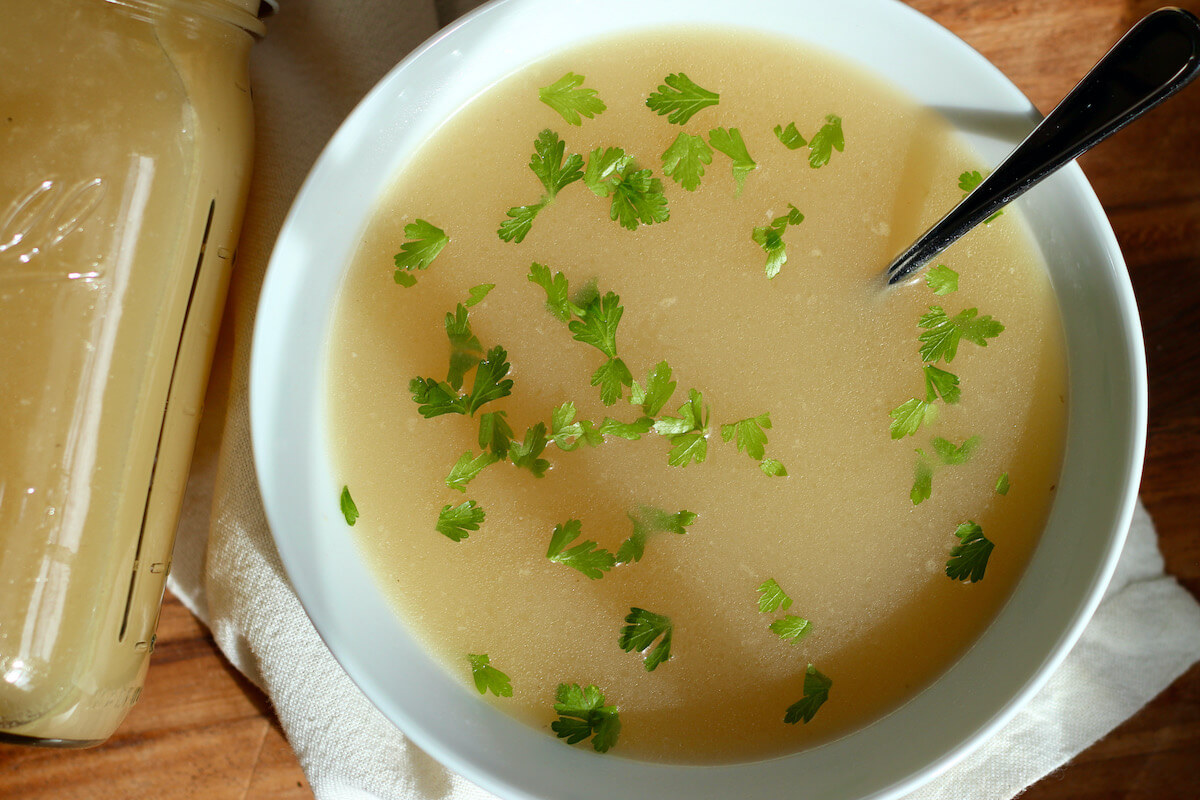
Don't toss that Thanksgiving turkey carcass! Reduce your kitchen waste by turning it into flavorful turkey stock instead.
This turkey bone broth recipe is the one I make every November after my holiday feast. It's slowly simmered on the stovetop to create a collagen-rich stock that becomes the base for delicious soups, stews, and winter comfort dishes.
It's become one of my favorite post-holiday traditions in my kitchen, and it's a wonderful way to make the most of your Thanksgiving leftovers.
Today, I’m walking you through how to make the best turkey bone broth, including which ingredients to use, tips that guarantee it turns out right the first time, and how to use it to make your holiday meal taste delicious.
Disclaimer: Some links throughout this post are affiliate links. As an Amazon Associate, I earn from qualifying purchases. You can learn more by visiting my Affiliate Disclosure Page.
What is Turkey Bone Broth?
Turkey bone broth is a nutrient-rich stock made by simmering turkey bones, often along with vegetables, herbs, and apple cider vinegar, over an extended period of time. This process extracts flavors, minerals, and gelatin from the bones.
Difference Between Bone Broth and Stock
Turkey stock and turkey bone broth are very similar because they are both made by simmering turkey bones. The key difference is that bone broth is simmered longer and sometimes includes apple cider vinegar to extract more collagen, resulting in a jello-like consistency when cooled.
On the other hand, turkey broth is made by simmering primarily turkey meat for a shorter time, resulting in a less rich and flavorful liquid.
Why You'll Love This Recipe
- Easy to Make- Just add all the ingredients to the pot, simmer, and strain. It couldn't be more simple!
- Better Flavor- Rich, savory, and aromatic, homemade bone broth has a deeper, more delicious flavor compared to store-bought options.
- Versatile- Use turkey stock as a flavorful base for soups, stews, risotto, sauces, and more.
- Cost-Effective- Making turkey bone broth with leftover turkey bones and vegetable scraps is practically free and reduces kitchen waste.
- Healthy- Homemade stock is rich in vitamins, minerals, and collagen. Plus, by making it from scratch, you have full control over the quality of the ingredients.
- Enhance Holiday Recipes- Elevate your holiday meals by adding a rich, homemade flavor to gravies, stuffings, casseroles, and more.
Ingredient Notes
Here are some notes on the key ingredients. For the full list of ingredients, check out the recipe card below.
- Turkey Bones- Use any leftover turkey bones you have, preferably with some meat and cartilage still attached. This recipe is an excellent opportunity to repurpose bones from your Thanksgiving turkey or my braised turkey breast recipe.
- Water- Start with cold, filtered water for the best flavor.
- Apple Cider Vinegar- The acidity of the apple cider vinegar helps extract collagen and minerals from the bones. It does not add any noticeable flavor to the stock.
- Onion- The onion's skin can be left on for a richer color in the broth.
- Carrots- Carrots enhance the color of the broth and add a subtle sweetness.
- Celery- Thoroughly wash celery to remove any dirt. No need to trim the celery leaves as they will add more flavor to the broth.
- Garlic- Crushing the garlic cloves helps release their aromatic oils. Again, you can leave the garlic skin on.
- Thyme- Adds a subtle, herbaceous flavor to the stock that pairs well with turkey.
- Bay Leaf- Enhances the flavor of the broth and adds an earthy flavor.
- Kosher Salt- Opt for kosher salt over table salt as it does not contain added ingredients like sugar or anti-caking agents.
🌱 Sustainability Tip: Freeze leftover turkey bones and vegetable scraps for convenient, cost-effective homemade turkey bone broth that also helps reduce food waste.
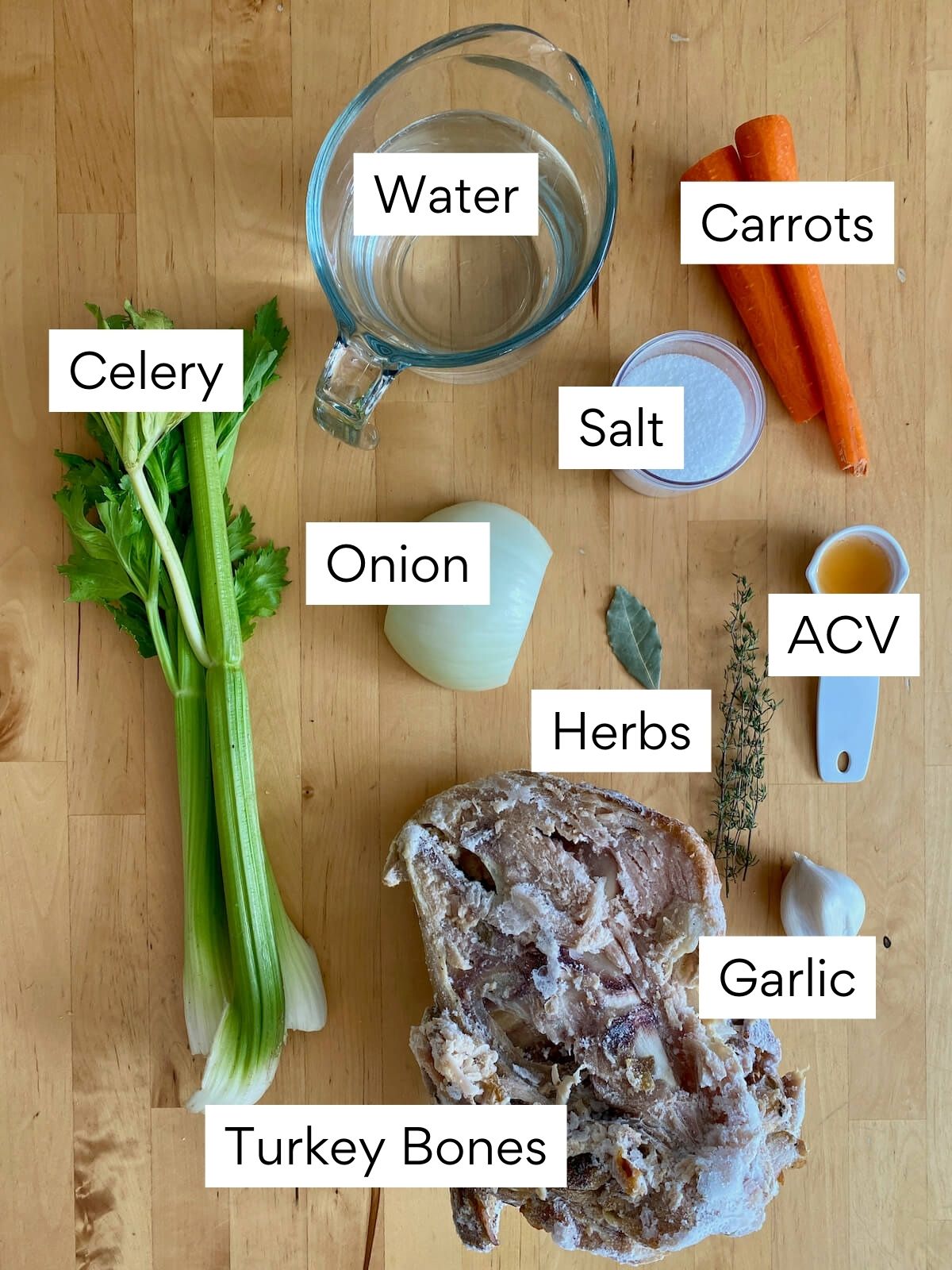
Substitutions and Variations
Here are a few ways you can try customizing this turkey stock recipe to fit your diet and taste preferences.
Substitutions
- Turkey Bones- This recipe is versatile and can be adapted to make chicken or beef bone broth. Feel free to use any combination of bones you prefer.
- Apple Cider Vinegar- Swap apple cider vinegar for distilled white vinegar or lemon juice.
- Aromatics- Customize the aromatic vegetables to use what you have on hand, or skip them altogether. Leeks, shallots, fennel, parsnips, and mushrooms can also be excellent choices.
- Herbs- Substitute the thyme and bay leaves with rosemary, sage, parsley, or marjoram.
- Kosher Salt- Swap for sea salt, Himalayan salt, or table salt.
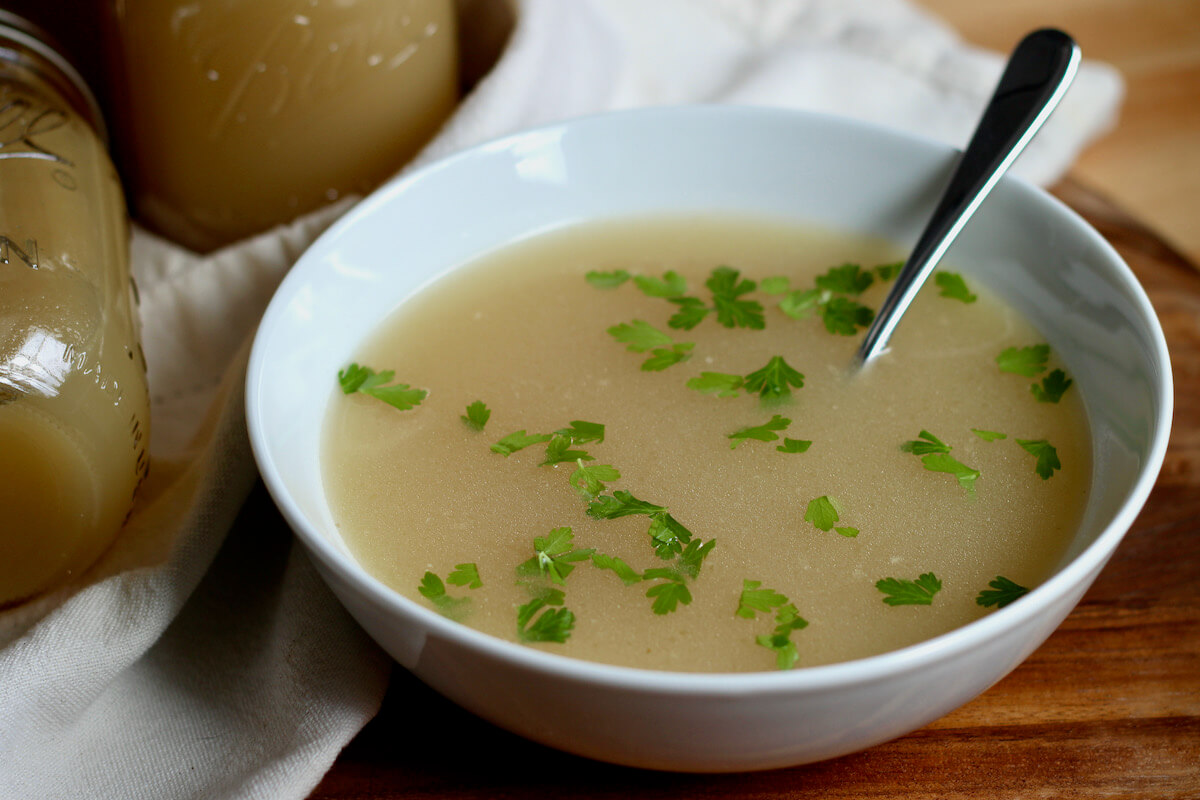
Variations
- Herbed- Enhance the flavor by including extra herbs like rosemary, sage, parsley, and marjoram.
- Lemon- Give your turkey broth a fresh, citrusy flavor by adding a few slices of fresh lemon.
- Mushroom- Add dried cremini or shiitake mushrooms to give the broth a richer umami flavor.
- Turmeric & Ginger- Fresh turmeric and ginger can give the broth a spicy, warm, and aromatic taste.
Equipment Notes
Here are some notes on any special equipment I used to make this recipe.
- Large Stockpot- Ensure your stockpot is large enough to comfortably fit all the ingredients and allow for simmering. I recommend using at least a 12-quart stockpot.
- Fine Mesh Strainer or Cheesecloth- A fine mesh sieve or cheesecloth is essential for straining out the solid ingredients from the broth, resulting in a clear, smooth liquid.
How to Make Turkey Bone Broth
Here is how to make turkey stock on the stovetop.
Step 1: Add all ingredients to the pot. Place the turkey bones, onion, carrots, celery, garlic, fresh thyme, bay leaf, apple cider vinegar, and kosher salt into a large stockpot. Pour in the water, ensuring that all the ingredients are well-covered.
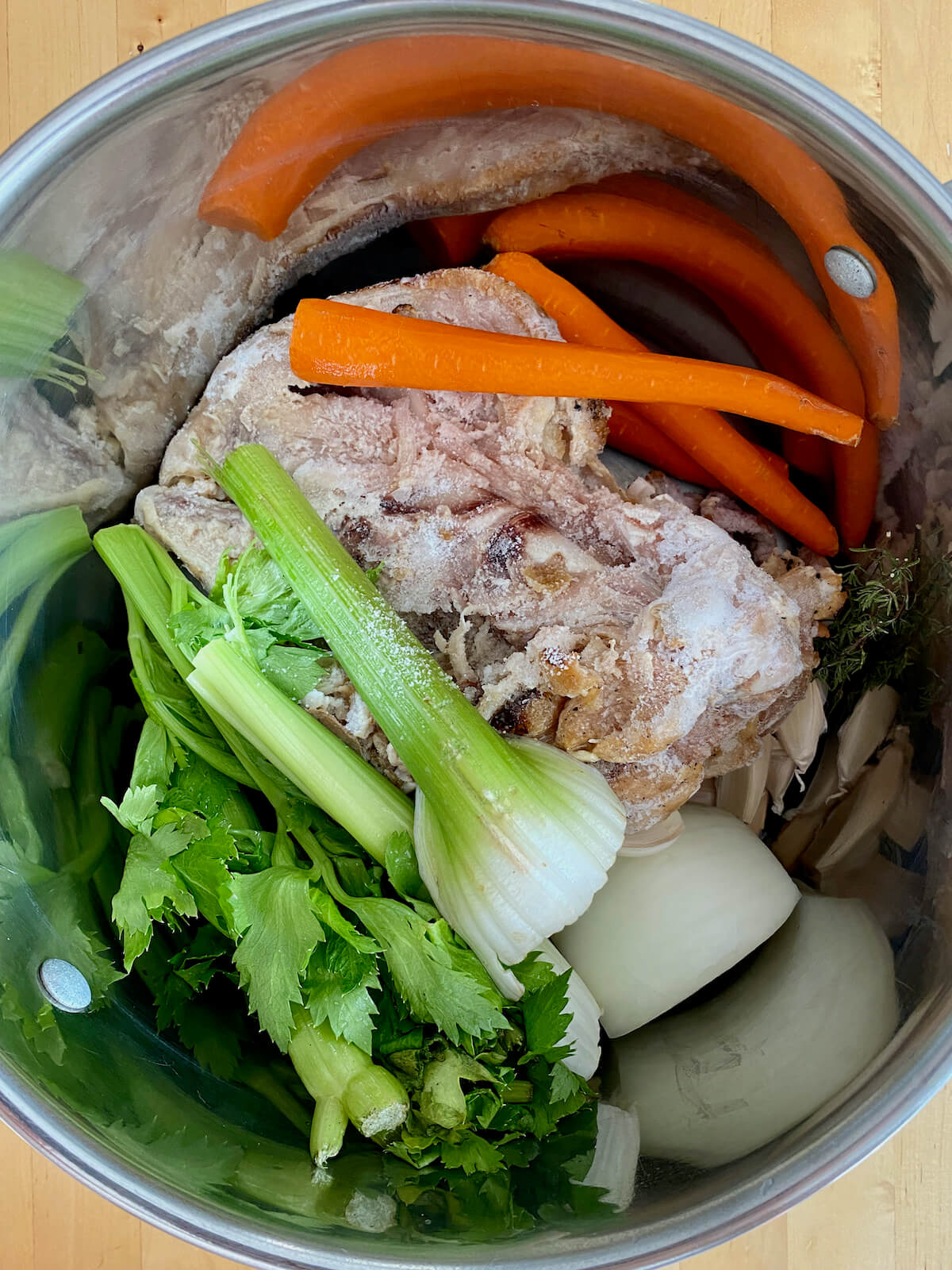
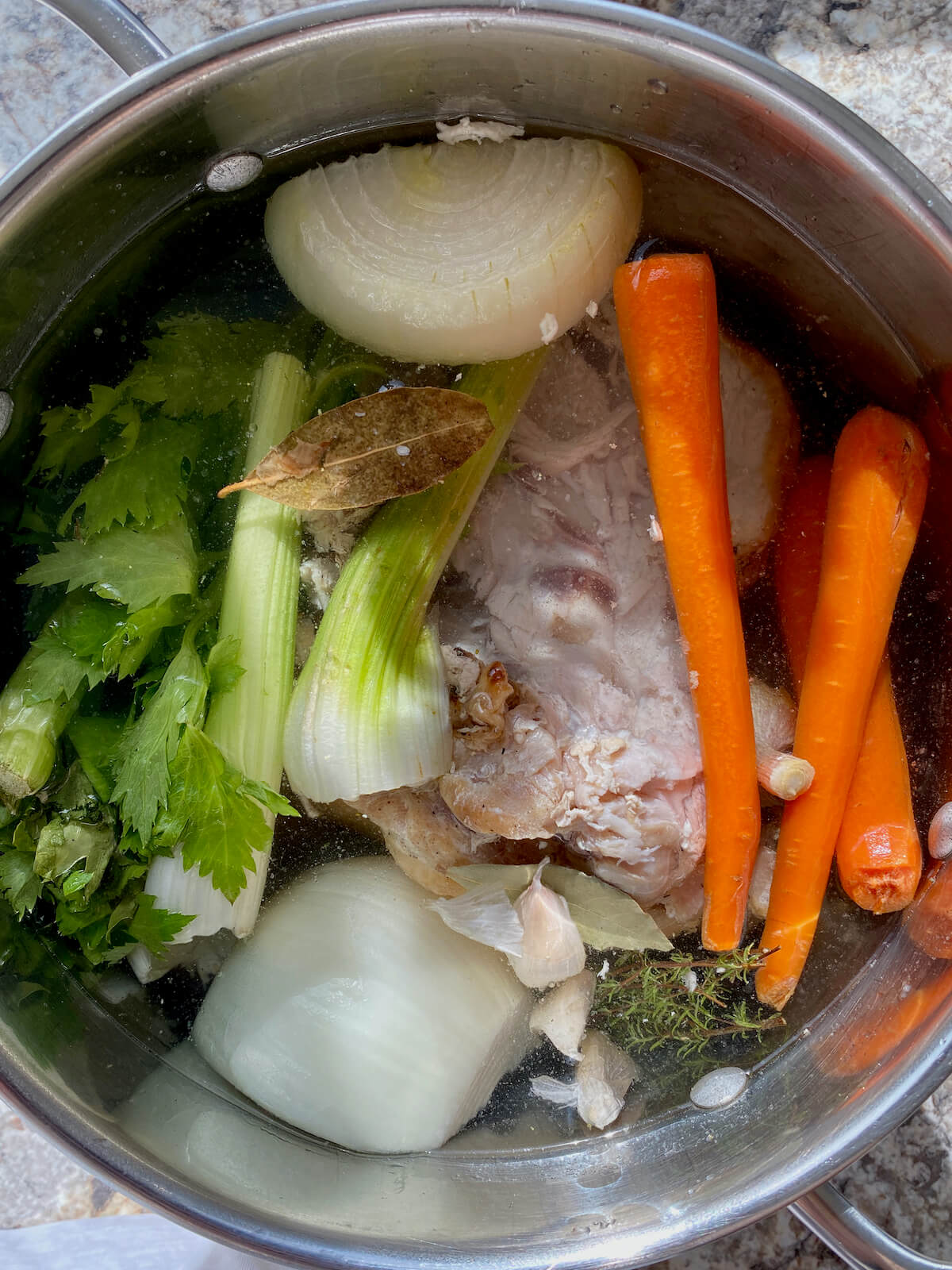
Step 2: Bring to a simmer. Bring the water to a boil over medium-high heat. Once boiling, reduce the heat to low and allow the broth to gently simmer. As the broth is simmering, periodically skim off any foam that rises to the top using a spoon. This helps to clarify the broth.
Step 3: Simmer the stock. Cover the stockpot and let the broth simmer for 10-12 hours.


Step 4: Strain the stock. Carefully strain the turkey stock into a large bowl or container using a fine mesh sieve or cheesecloth.
Step 5: Use or store. At this point, you can use the turkey broth immediately or you can portion it out for future use. Store the broth in airtight containers in the refrigerator for up to a week, or freeze it for longer-term storage.
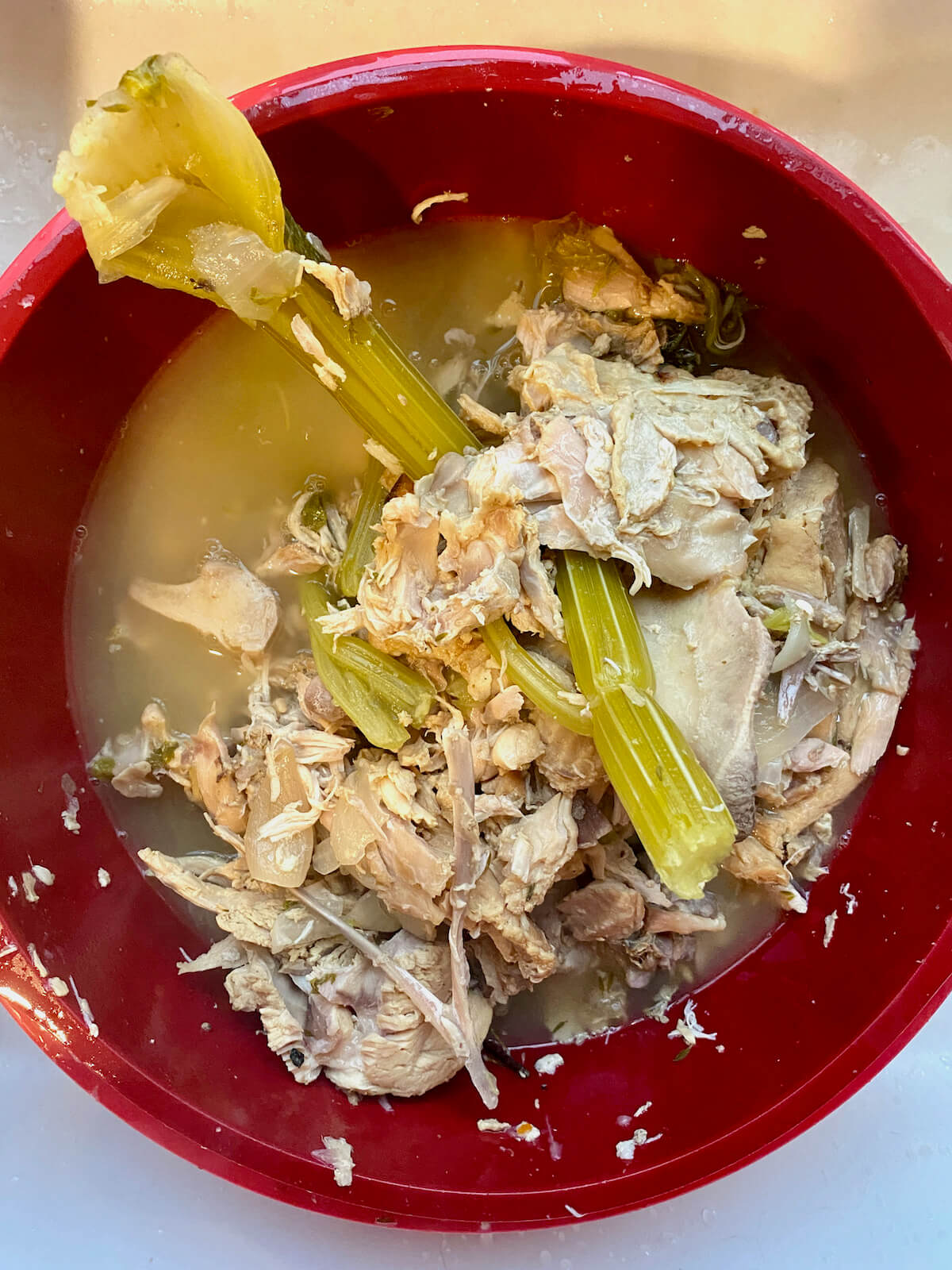
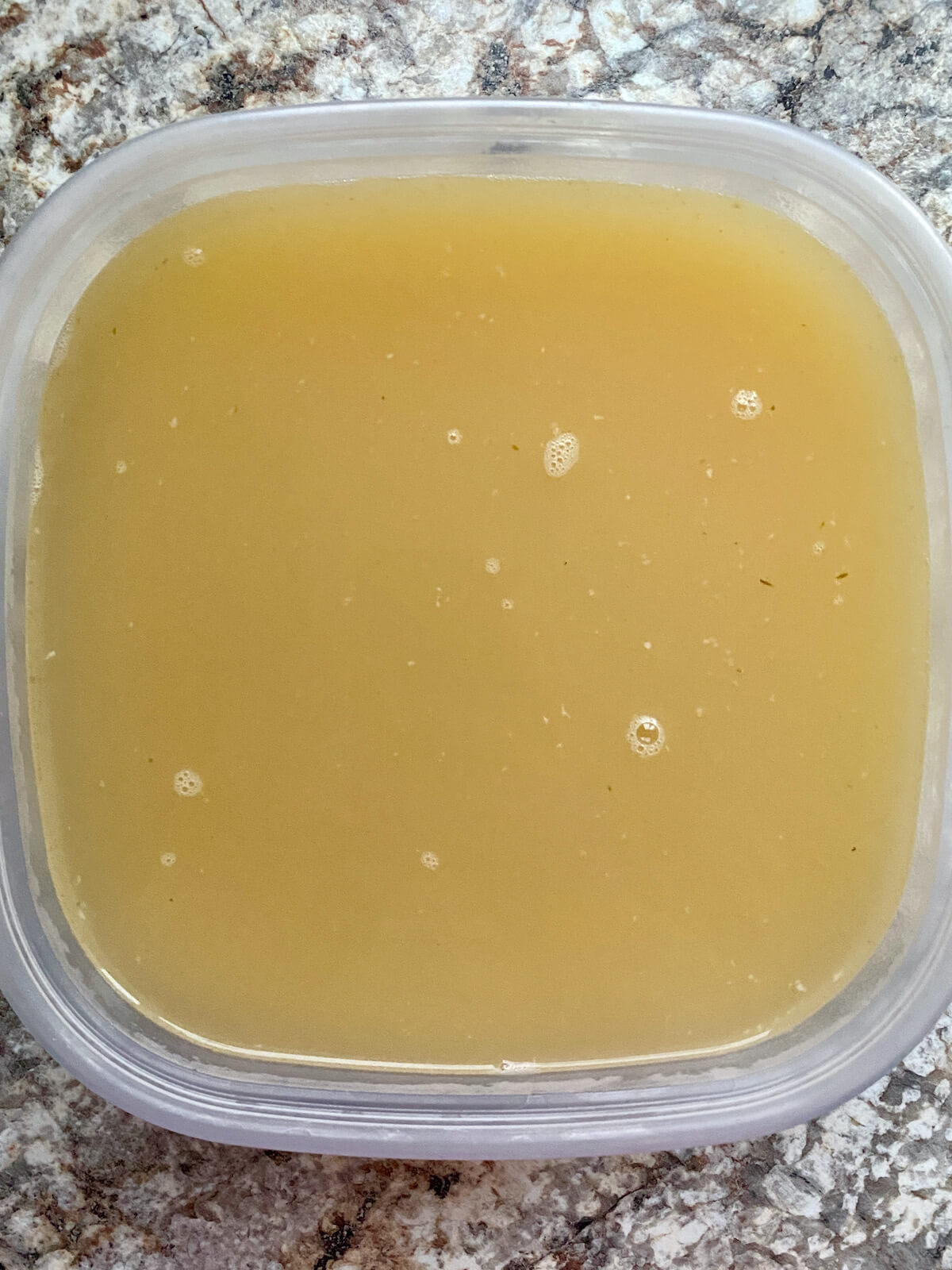
Turkey Bone Broth (Video)
Tips for Success
Make this easy turkey bone broth recipe successfully the first time using these helpful kitchen tips.
- Save scraps. Save scraps in a freezer bag, including turkey bones, vegetable peels, ends, and garlic/onion skins. When the bag is full, use it to make a convenient batch of stock.
- Plan ahead. Choose a rainy day when you can be home for the 12-hour simmering process to make a batch of turkey bone broth.
- Make a double batch. Consider making a double batch if your stock pot allows. Freezing extra broth is a smart way to maximize your efforts on stock-making day.
- Roast your bones. For richer flavor, roast raw bones at 400°F for 20 minutes before adding them to the stockpot.
- Skim off foam. Periodically skim off any foam that rises to the top during simmering to maintain a clear, clean-tasting broth.
- Salt to taste. Start with a modest amount of salt and adjust as needed. Remember, it's easier to add more later than to correct over-salting.
- Reduce fat. If you'd like to reduce the fat content, refrigerate the broth overnight. Once cooled, you can easily skim off any solidified fat using a spoon.
How to Use Turkey Bone Broth
Homemade turkey stock is highly versatile and can be used to enhance the flavor of a variety of your favorite recipes. I often rely on it to make my holiday favorites, like braised turkey breast, turkey pot pie, gravy, stuffing, and mashed potatoes, more flavorful.
Turkey bone broth is also perfect for cooking and flavoring grains like rice, farro, quinoa, and risotto.
Finally, use this turkey broth to make your favorite soups and stews taste even better. Try it in turkey wild rice soup, turkey noodle soup, turkey pumpkin chili, and more.
Storage and Reheating
How to Store
- Refrigerator- Store turkey bone broth in an airtight container in the refrigerator for 3-4 days. After that, it's best to portion it into smaller containers and freeze it.
- Freezer- For longer storage, freeze turkey bone broth in freezer-safe bags, wide-mouth mason jars, or containers for up to 6 months.
- Canning- If you own a pressure canner, canning your homemade turkey stock will make it shelf-stable for 1-2 years as long as you follow proper canning guidelines.
🌟 Quick Tip: Quickly cool the stock before refrigerating by using an ice bath or dividing it into smaller containers. This helps prevent bacterial growth and keeps your refrigerator at the right temperature.
How to Reheat
- Stovetop- Pour turkey bone broth into a saucepan and set it over medium-low heat. Heat until steaming hot and just about to simmer.
- Microwave- Place leftover turkey bone broth in a microwave-safe bowl or cup. Heat on HIGH in one-minute intervals, stirring between each, until piping hot.
Make Ahead
Homemade turkey stock is perfect for making ahead of time.
In fact, I always make a big batch around the holidays so I have it on hand in my freezer. Having a supply of turkey stock readily available not only saves time but also adds a wonderful depth of flavor to holiday dishes.
🌟 Quick Tip: Freeze turkey stock in ice cube trays to create convenient, small portions perfect for enhancing homemade sauces.
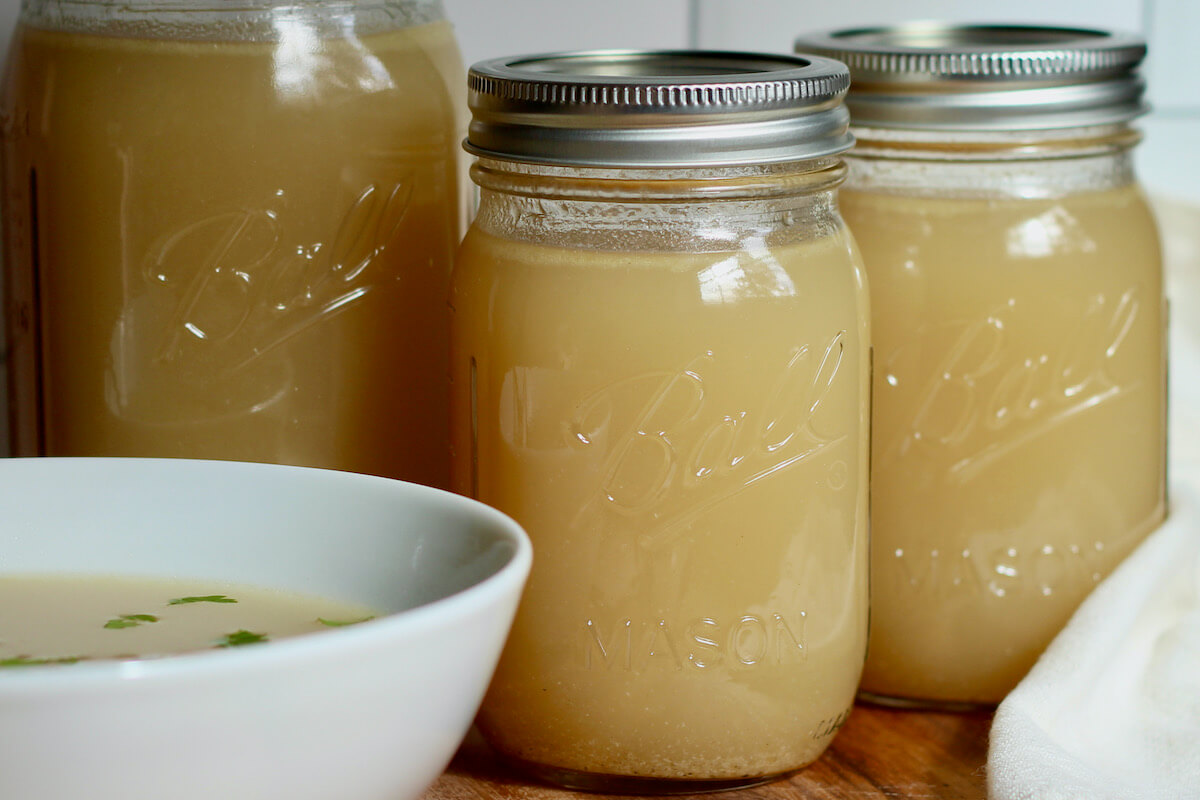
Frequently Asked Questions
For making turkey stock, a common guideline is to use approximately 1-2 pounds of turkey bones for every gallon of water.
For the best turkey bone broth, it's ideal to use a combination of bones that include a mix of meat, cartilage, and connective tissue. This ensures a rich and flavorful broth with a good gelatinous quality.
If you don't have a large stockpot, you can halve the recipe or use two smaller pots. Just be sure everything is well-covered with water.
Yes, it's perfectly normal for well-made bone broth to have a gelatinous consistency when cooled. This indicates a high collagen content, which is a sign of a broth rich in nutrients and flavor. It will turn back into a liquid once reheated.
Absolutely! Turkey stock can be used interchangeably with chicken stock or chicken broth in most recipes for added flavor.
Let's Connect!
Be sure to leave a comment below if you have any questions. You can also connect with me on Instagram, Facebook, Pinterest, or via email at [email protected].
More Broths & Sauces
📖 Recipe
Turkey Bone Broth
Ingredients
- 2 pounds leftover roasted turkey bones
- 1 large onion quartered
- 3 large carrots cut into large pieces
- 3 stalks celery cut into large pieces
- 6 cloves garlic crushed
- 6 sprigs fresh thyme
- 1 bay leaf
- 1 tablespoon apple cider vinegar
- 1 teaspoon kosher salt
- 20 cups water
Instructions
- Place the turkey bones, onion, carrots, celery, garlic, fresh thyme, bay leaf, apple cider vinegar, and kosher salt into a large stockpot. Pour in the 20 cups of water, ensuring that all the ingredients are well-covered.
- Bring the water to a boil over medium-high heat. Once boiling, reduce the heat to low and allow the broth to gently simmer. As the broth is simmering, periodically skim off any foam that rises to the top using a spoon. This helps to clarify the broth.
- Cover the stockpot and let the broth simmer for 10-12 hours.
- Carefully strain the turkey stock into a large bowl or container using a fine mesh sieve or cheesecloth.
- At this point, you can use the turkey broth immediately or you can portion it out for future use. Store the broth in airtight containers in the refrigerator for up to a week, or freeze it for longer-term storage.
Notes
- Quick Tip: If you'd like to reduce the fat content, refrigerate the broth overnight. Once cooled, you can easily skim off any solidified fat using a spoon.
- Storage: Store turkey stock in an airtight container in the refrigerator for up to 4 days or freeze for up to 6 months. Quickly cool the stock before refrigerating by using an ice bath or dividing it into smaller containers. This helps prevent bacterial growth and keeps your refrigerator at the right temperature.


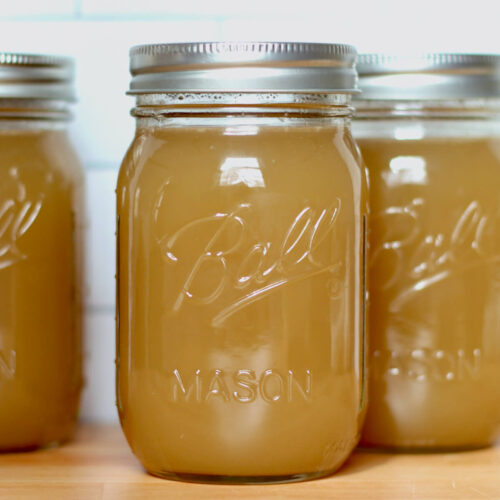





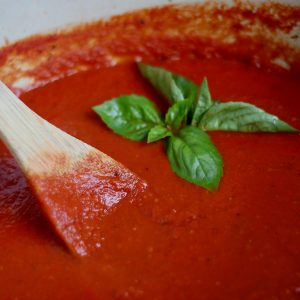
Comments
No Comments